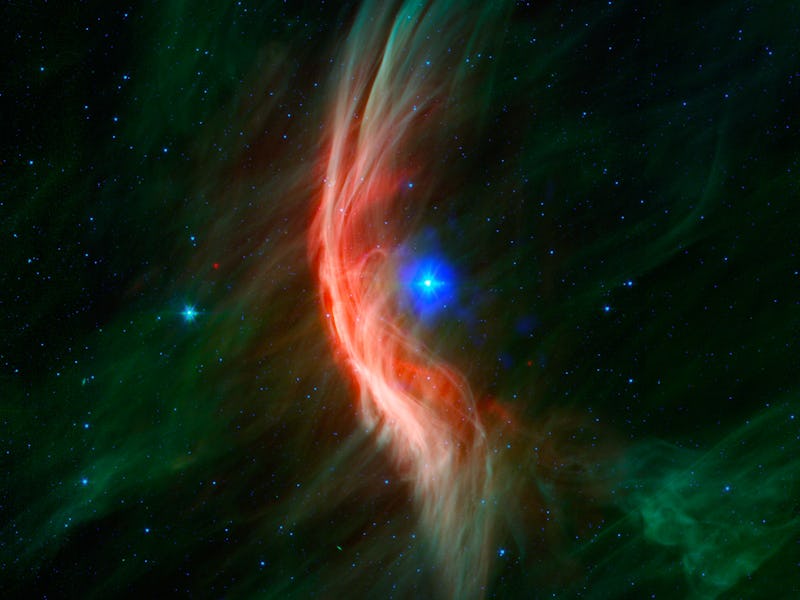Look! NASA publishes new image of a fast-flying star ejected by a supernova
The gas around the speedy star is heated to tens of millions of degrees.

Like the sea that ripples in front of a traveling ship, so does a magnificent shockwave of gas precede a fast-flying star.
On July 25, NASA published a new view of the moving star Zeta Ophiuchi that merges an existing infrared image of this bright object with X-ray data. Most of the details in this composite image — the shock wave in red, the filaments of former star material in green, and the background stars — are visible thanks to infrared data that the now-retired Spitzer Space Telescope collected ten years ago.
Unlike the infrared data that gives heat information to astronomers, the X-ray observations marked here as a glowing blue orb around the star tell researchers that a cosmic crash is really raising the heat.
This new image helps our eyes understand Zeta Ophiuchi’s wild story.
Zeta Ophiuchi is located 440 light-years from Earth.
The star, which shines 80,000 times brighter than the Sun, travels 100,000 miles per hour through space because of a turbulent termination.
According to Spitzer representatives, Zeta Ophiuchi shared its former corner of the Universe with another star. But one day, this companion blew up as a supernova. Its demise was potent enough to launch Zeta Ophiuchi on a journey through space.
What’s new — This gorgeous view from Spitzer now contains X-ray information from another major NASA spacecraft, the Chandra X-ray Observatory. Zeta Ophiuchi is bombarded here by its own shock wave, heating it up to incredible temperatures. Astronomers think that the shock wave causes the gas around the star to reach tens of millions of degrees.
An illustration of NASA’s Spitzer Space Telescope.
Why it matters — Zeta Ophiuchi’s story gets more complicated.
The bow-shaped shockwave puzzles a research team led by Ph.D. candidate Samuel Green from the Dublin Institute for Advanced Studies in Ireland, according to NASA’s image description. After the team ran computational models, they found that their renderings suggest a fainter glow than what they see in the X-ray data. The findings don’t match.
To make the computer’s data and the image’s details match, new models that contain information on other forces of physics may be the answer. If they add phenomena like the disordered behavior of gas called turbulence and the acceleration of particles into their analysis of Zeta Ophiuchi, then maybe these discrepancies will resolve and data will be in “agreement” with the X-ray data.
For now, scientists and citizens can enjoy the sight of Zeta Ophiuchi’s frenzy from 440 light-years away.